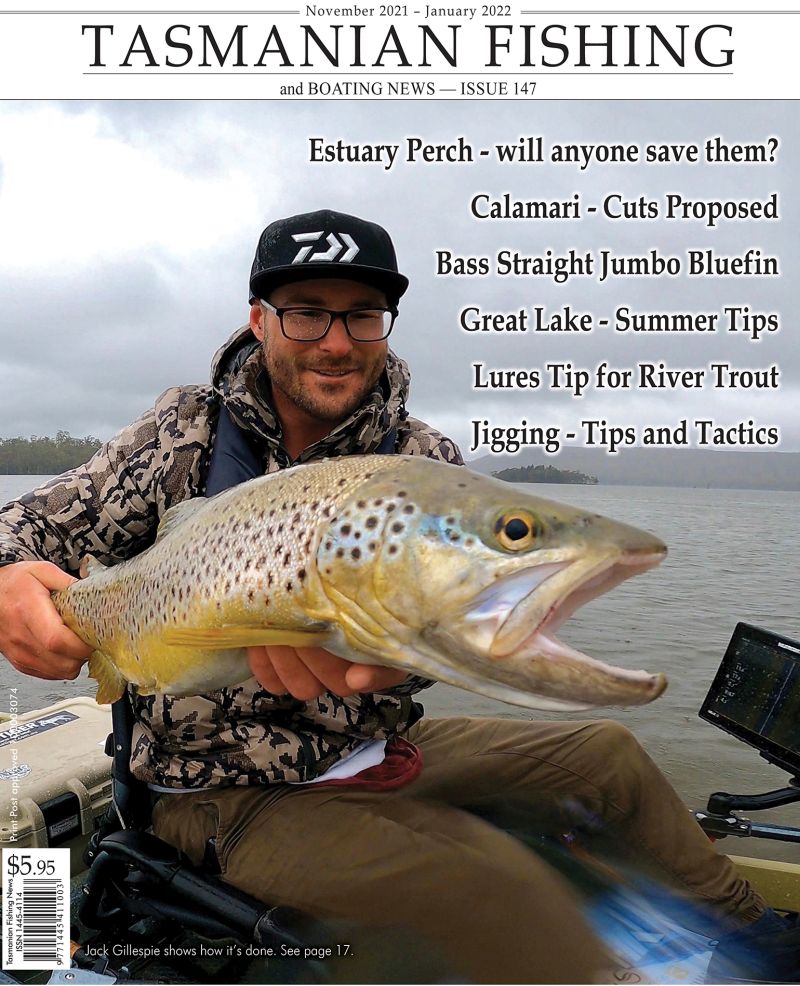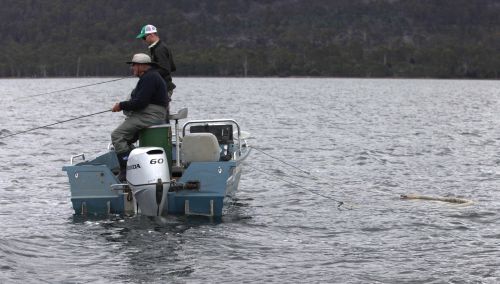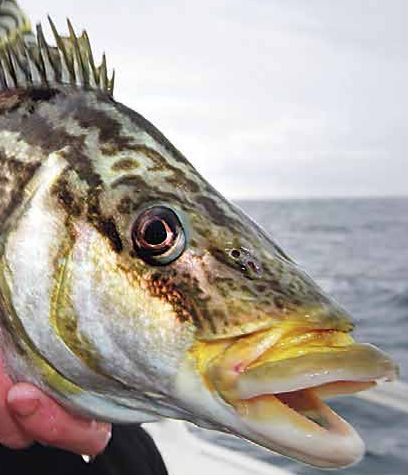 Presented from Issue 103, April 2013
Presented from Issue 103, April 2013
The fish
Tasmania’s coastal waters are fast gaining a reputation of having some of the best variety and quality of fishing in the southern half of Australia. Every season for the last decade or so we seem to be experiencing new and unusual species migrating into our waters and revised management strategies are ensuring that fisheries are protected for future generations. There is one particular species though that has stood the test of time and has the potential to really put us on the map and that is Latris lineata or the striped trumpeter.
Quite often classed by Tasmanians as “one of the best eating fish in the sea”, the striped trumpeter, or sometimes known as the Tasmanian trumpeter, are mainly caught off the coast of Tasmania, but can be caught in South Australia and Victoria and are also found in New Zealand and South American waters. They are reported to grow up to 1.2m in length and about 25kg in weight and live for up to 30 years.
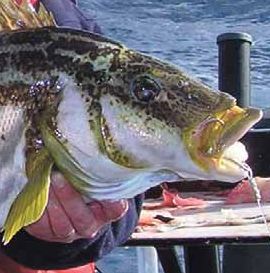 Around Tasmania spawning occurs between the months of July and October and typically a single fish of 3.2kg can produce 100,000 eggs. Females reach maturity at around 45cm or 5 years old, while males reach maturity at around 53cm or 8 years old. Larvae go through an extended larval phase of around 9 months before settling on inshore reefs. The inshore reefs are where most recreational fisherman targets the smaller fish but often venture wider to the outer reefs in search of the larger specimens.
Around Tasmania spawning occurs between the months of July and October and typically a single fish of 3.2kg can produce 100,000 eggs. Females reach maturity at around 45cm or 5 years old, while males reach maturity at around 53cm or 8 years old. Larvae go through an extended larval phase of around 9 months before settling on inshore reefs. The inshore reefs are where most recreational fisherman targets the smaller fish but often venture wider to the outer reefs in search of the larger specimens.
Over the last few years access to larger offshore boats has become easier and technology in the form of depth sounders and GPS has advanced greatly making the job of finding the fish in deeper waters no longer guess work. This has opened up a once mystified and secret fishery known only to a few to the every day angler.
What follows is an in depth look at some of the techniques, tips and tackle involved in successful Striped Trumpeter fishing.
Locations and techniques
During the late winter and early spring months the fish come into the inshore reefs to spawn and can be caught in water as shallow as 30-50 metres, this means you don’t necessarily need to venture too far from shore to catch a feed of fish, however being more easily accessible to the hoards of other anglers the closer grounds can cop a lot of pressure and fish numbers will be low.
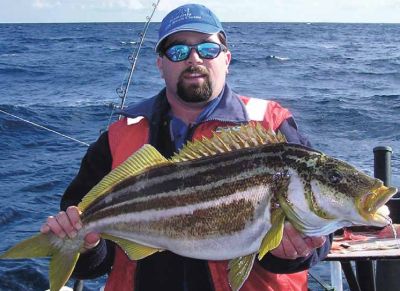 |
| The author, Jamie Henderson showing his form |
To start catching large fish and good numbers the outer reefs are definitely a better choice, looking for bottom in the 100-300 metre depth range will have you on some prime territory and usually away from the pressure of weekend danglers. Also don’t become too wrapped up in sourcing “Secret Spots” and GPS marks of mystical fish producing reefs that other fisherman keep hidden away.
Plenty of good stripey bottom has, and can be, found by accident so don’t discount any good looking reef you see on your sounder. Every bit of reef is worth a look and some key points to look for are nice high pinnacles that jut straight up from reef or on the edge of the reef, good holes and sheer drop-offs and reef structure that runs along the edge of a contour line.
Quite often we have fished a patch of reef that produced good fish last trip only to be seemingly devoid of fish this time, a quick move to more reef nearby has found fish and a move again found even more, the general rule of thumb is if the reef looks good give it a try, if no fish are on the chew within 15-20 minutes pull up and try another section or patch of reef.
The underwater currents and tides play a very important role in where the fish will be situated in relation to the reef, obviously it is hard to gauge what the underwater currents are doing 100 metres down or more, but as you drift with the tide you will get an idea of the direction. While the tide is running hard try drifting onto the face and off the back edge of the reef, the fish hold in these areas using the currents much like a trout in a stream to maintain a position whilst using the least amount of energy and have food items carried to them by the current.
Also try the deeper holes and crevices during this time as the fish will also hide in them to keep out of the strong current, as the tide slows drift across the reef proper as many fish will take this opportunity to move about on the reef hunting out other food items. In order to do this effectively you need to be on the water when there is minimal wind, being Tasmania this is not always easy but study the weather forecasts and try and aim for days where wind of 5-15 knots will be predicted. Up to 10 knots is fine but once it becomes higher the drift rate increases to a point where contact with the bottom is almost impossible, at this point sea anchors can work well but having someone on the controls of the boat and driving the boat in reverse to hold station will be the best method.
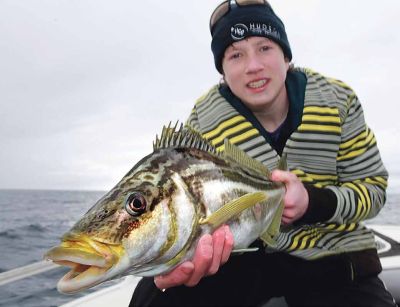 |
| Bailey Zanetto with an east coast stripey |
Apart from a seaworthy ocean going boat there are a couple of key pieces of equipment that are needed to help locate areas where striped trumpeter will be. These are a powerful high resolution depth sounder and a GPS or chart plotter, the sounder to locate reefs, structure and fish and the GPS to mark any likely spots to come back to. Being able to use your depth sounder effectively is paramount to finding good stripey bottom, units with a minimum of 500 watts and dual frequency, 200 and 50khz, should be used, units of 1Kw tend to be more popular for their ability to read better at depth. A high pixel count on the screen will give a much more defined picture and whilst monochrome units with a high level of grey scale will give an excellent picture and good definition, colour units will give better density readings and allow you to determine better target separation between individual fish and structure.
When using the sounder turn all the automatic controls off and run the unit on full manual, this will allow you to constantly adjust the settings such as gain or sensitivity to suit the depth and conditions, try using gain and sensitivity on its maximum limit only tapping it back a fraction until screen clutter starts to disappear and then the unit will be reading at its best.
Once a patch of reef has been found a useful feature that some sounders have is the ability to set an upper and lower depth limit. If for example you are fishing in 100 metres of water looking at the top 70-80 metres is a waste of time as the striped trumpeter schools will hold within 20 metres of the bottom. If the unit has this feature set the upper limit to 80 metres and the lower limit to 105 metres and this will allow the sounder to display only the information in the bottom 25 metres of water and give you a much better picture with more detail of what is on the reef.
At this stage it is quite common to see elongated arches and constant lines across the screen and these will be individual fish feeding, also look for masses of bait schools on or near the bottom as where there is bait there will be stripey. Quite often you will see a bait school sitting just off the tip or the edge of a sharp drop or pinnacle and this is a prime feature to drop a bait onto.
Some popular East Coast locations to try are Merricks Reef, Middle Ground, Pulfers Reef, Binalong Patch, The Cliff and the Eddystone Patch. These are all good reef areas to try your hand at catching a few stripey but are also good base points to prospect around and see what other reef structures come up.
Like I said before there are really no secret magic spots that produce fish all the time, you need to search around and find good reef and drop a bait down to really get an idea of what’s going on, if no fish come aboard within a short time move on and find another reef.
Tackle
This is one area where skimping on quality gear is not an option, rod and line fishing for striped trumpeter is hard on tackle and hauling large hard fighting fish from 100 metres or more of water tests reel gears, line rollers, bail arms and rod guides to the limit. Many cheaper reels just don’t have the quality internal gearing and bearings to be able to cope with the torture of continuous winding under extreme load and when stripey fishing this is what outfits will spend the majority of their time doing.
Dropping 500-1000 grams of lead to the bottom and systematically winding up 5-7 kilogram fish — often 3-4 fish on one rig, is enough to strip the gear teeth and warp shafts of sub standard reels. One simple outfit capable of taking the punishment is an Alvey 825BCV combo, this is the Alvey 825BCV deep sea reel, a 1:1 ratio direct wind reel with an anti reverse, strong star drag and is as tough as nails coupled with a stout Alvey 5’6” heavy boat rod. Whilst it is not cutting edge technology nor does it look overly flash hanging out of the rocket launcher of a Gucci offshore fishing boat it does a superb job of hauling fish aboard with a minimum of fuss other than some grunting from the angler.
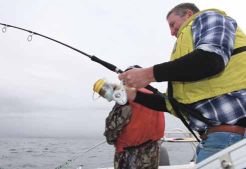 |
| Big eggbeaters are popular |
By far the best type of reel to use is a good quality large spinning reel, they are easy to use but make sure you choose a quality model capable of handling the job. Large spool capacity is vitally important to hold enough braid to be able to fish in depths up to 300m and will rule out many spinning reels most of which are cheaper surf style reels with inadequate quality components for the job.
Lever drag overhead reel are option, they can hold a much larger capacity of line than a spinning reel but become awkward when not used to having a heavy weight on top of the rod in a boat that’s pitching and rolling, important when fishing the depths required for big striped trumpeter. Look for a reel with stainless steel bearings if possible and don’t necessarily go for the lightest models, a bit of weight indicates they are solid and strong in the housing and gearing, after all it will be used as a workhorse.
Another aspect when choosing a reel is the retrieve ratio. Many discussions have been had over whether a high speed reel is better than a low speed reel but at the end of the day the reel will wind in line only as fast as you can wind the handle, remembering that when there is a lot of weight and fish at the other end its you that has to do the work. A high speed reel is great for recovering line fast but with a lot of weight on the end will become difficult to wind quickly and will tire you fast; on the other hand a low ratio reel will wind with ease even with a lot of weight but will take a lot longer to get to the surface.
Also a low ratio reel when spooled to capacity with line will have a faster retrieve ratio as the spool diameter has been increased, as too will the high speed reel which then may become far too difficult to wind when 2 or 3 large trumpeter are on the other end trying to swim back to the reef. Rods need to be strong and in the 15-24 kilogram ranges, short 5-6 feet, have a fast taper and quality guides suitable for braid, this makes it easier for the angler to pump and wind and short stroke the fish to the surface. This is no time to be sporting as striped trumpeter hit hard and then aim for their hole in the reef, you need to stop them fast or risk being hung up or busted off on the reef. A short rod with a fast taper will load quickly and still have power in the butt section to fight the fish.
As far as line is concerned there is only one choice and that is to use a quality braid, usually between 30-60lb depending on the rod and reel being used. Braid, which has less stretch than monofilament, will allow greater line capacity on the reel, feel the bites better, feel when your sinker hits the bottom and allow you to stay in contact with it and most important of all being a finer diameter for its breaking strain then the equivalent mono will have less drag in the water and be less effected by underwater currents and tides.
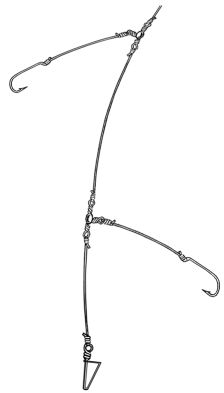 |
|
You can use a simple Paternoster |
Bait and Rigs
Being a reef dwelling fish the striped trumpeters diet mostly consists of octopus, squid, crustaceans and small fish so using baits found naturally in their environment will produce the best results. Try and use baits that as fresh as possible and not just some scrap you have had laying around in the freezer for a while, trumpeter can be fussy eaters. I have found that fresh squid or octopus produces excellent results, some commercial fisherman even swear by garfish, don’t be shy with the amount you put on the hook either, give them plenty to chew on. One of my regular fishing partners even swears by using fillets of fresh gurnard that are an unwelcome by catch when stripey fishing, being fresh from the water they are a high quality bait and do seem to work well. In conjunction to the bait I like to use something that glows in the dark, usually this is a 5” B2 Candy Squid from Luhr Jensen slipped onto the hook shank before the bait is placed on, these not only act as an attractant in the dark water but if the bait is picked off by smaller fish there is still a lure on the hook that the fish may go for. Other alternatives to this are plastic glow beads or glow tubing placed on the trace above the hook, whatever the item I have found that something that glows increases the activity especially when the fish are thin on the ground.
As far as bottom rigs go keeping things simple is the best idea and a standard paternoster rig, albeit a heavy duty version is the basis for this. Mainline breaking strains are always a subject of much conjecture and I have tried anything from 80lb through to 450lb, some people will argue that a lighter leader will catch more fish; personally I don’t think that in the dark murky depths it will make a whole lot of difference. A lighter mainline will certainly be thinner and will give less drag in the currents but will also be easier to cut through on some reef, it can also be difficult to handle when you are trying to lift fish aboard the boat and can result in cut hands if you do not wear gloves. A loop in one end should be crimped with some armor spring or tubing as a chaff guard where the swivel from the braid clips to and then 3-4 Branch Line Swivels should be slid on and crimped into place.
The Branch Line swivels work much better than normal cross line swivels because you don’t have to cut the mainline to put them on, just simply slide them onto the line position them where you want your spacing, one metre apart is good, and crimp them into place. From each of these swivels crimp on your trace material, anything from 50lb through to 200lb can be used once again up to the individual, I have tried fluorocarbon line for traces with great results and it is much harder and abrasive resistant for its relative breaking strain than normal mono trace. Keep the trace length relatively short, I find 20cm is more than adequate and crimp a hook on the other end; I also like to put a lumo bead or piece of lumo tube on the trace before I crimp the hook on just as an added attractant.
I get asked all the time what type of hooks are best for stripey fishing and the simple answer is any good quality heavy gauge hook designed for live baiting or set line fishing.
Circle or “sport” circle style hooks are a good choice as it allows the fish to practically self hook when it takes the bait with no need for the angler to strike and being that they hook the fish in the corner of the mouth make it easier to remove from the fish, sizes 4/0 through to 8/0 depending on the brand and style. One of my favorite styles is a commercial grade “Ezibaiter” style hook which is a type of circle hook but with a longer shank, they are a longline hook used by commercial fisherman are heavy gauge, commercial grade, quite inexpensive and very effective. Sizes 11/0 through to 14/0 can be used depending on the size of the fish in the area. At the sinker end of the rig simply crimp in a loop leaving about 2 metres between the last hook and the sinker loop, very few striped trumpeter are caught in this area just above the reef and is where you will mostly be annoyed by gurnard. From this loop tie a short length of lighter mono, around 50lb, and attach the sinker or lead weight to this, if in the event you snag the sinker on the bottom this lighter line will break and you get your whole rig back only minus the sinker, cheaper and better than losing the whole rig every time.
Basic large snapper style sinkers are the best as they sink nice and straight without twisting, 16oz through to 32oz should be kept on board to cover all scenarios of tide, drift and current.
The Catch
When your rig hits the bottom striped trumpeter are not the only fish that inhabits the reef, you will most certainly feel a bunch of small taps, 90% of the time this is the gurnard, a ugly looking red goggle eyed fish with lots of terrible spikes that if jabbed by one will have you in pain for hours. Be very careful handling these fish as a simple mistake can ruin a whole day on the water, one way of trying to avoid the Gurnard is to wind your rig up a few winds on the reel as soon as the sinker touches bottom. Other fish that you may come across are banded morwong or perch and big deep sea cod but when a big stripey hits you will know all about it, they are not shy about how they strike and they just grab the bait and head for the reef. This is when you need to have your drag locked up and hold on as quite often if the school is thick there will be more than one fish on the rig and its not uncommon to have a 3-4 hook rig loaded with fish all heading down.
Once you have pulled the fish aboard it is important to bleed them straight away and put them on ice as soon as possible, they are after all one of the finest eating fish in the sea and should be paid the respect they deserve. Leaving top table fish lying around on a deck in the sun for hours will spoil it very quickly and considering its worth up to $35+ per kg taking the extra care at sea will be evident when it hits the table. A few bags of ice placed in a decent ice box with a couple of buckets of sea water will lower the temperature nicely, enough that I challenge you to keep your hand in it for any length of time, and have the fish flesh firm by the time you are back at the ramp.
Being at sea fishing for Striped Trumpeter can be one of the more relaxing moments of fishing you are ever likely to experience especially when you are with a few mates, conditions that are suitable for drifting the reefs are usually are very comfortable for the angler as well, not something we get to have all that often. However relaxation can quickly turn into intense excitement when a couple of freight train Trumpeter hit your rig with the intent on pulling you over the side of the boat, if you manage to win the fight and haul the fish on board not only have you had some serious fun without too much danger but you end up with some fantastic table fare that will keep the wife and family very happy……. what more could you ask for.
Jamie Henderson
 |
|
Gurnard are the curse of the bottom fisher |
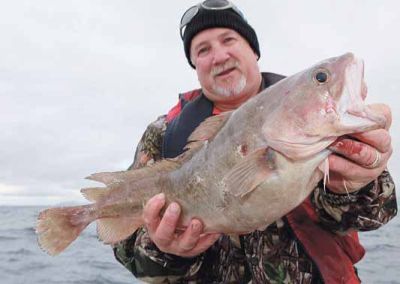 |
| Phil Zanetto with an often encountered monster cod |


